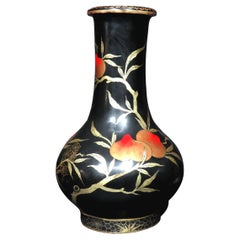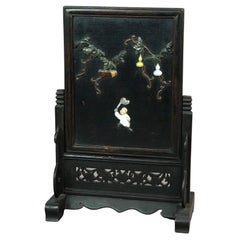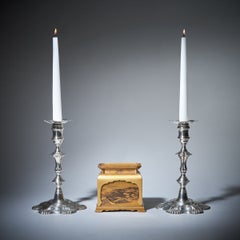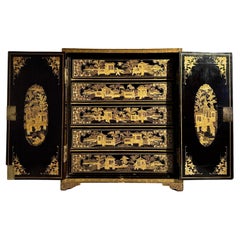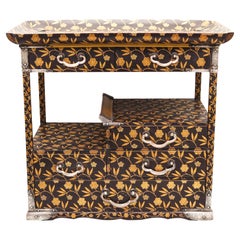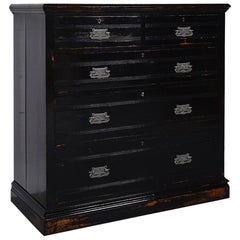Ebonized Lacquer
to
1
1
2
1
1
1
1
1
1
1
1
2
1
1
2
2
2
Technique: Ebonized
A Monumental 19th C. Ryukyu Hariko (Papier Mâché) Vase, Meiji Period (1868-1912)
Located in Ottawa, Ontario
A stunningly attractive & exceptionally large baluster shaped ‘Ryukyu Hariko’ (papier mâché) vase, masterfully decorated overall with hand painted images of a fruiting peach tree ren...
Category
Early 1900s Japanese Meiji Antique Ebonized Lacquer
Materials
Lacquer, Paper
Antique Chinese Hardwood Panel Table Screen With Hardstone Carved Figures 19th
Located in Big Flats, NY
Antique Chinese Hardwood Panel Table Screen With Hardstone Carved Figures in a Garden Setting19th C.
Measures - 15.5"h x 10.5"w x 5.25"d.
Category
19th Century Asian Antique Ebonized Lacquer
Materials
Stone
Related Items
Signed Mid 19th C. Edo/Meiji Period Miniature Lacquer Stacking Cabinet, Japan
Located in Oxfordshire, United Kingdom
The highly decorated tray in the form of a table frames a series of three stacking boxes, a further three lidded boxes and a tray concealed within, raised on ogee bracket feet.
This...
Category
19th Century Japanese Meiji Antique Ebonized Lacquer
Materials
Lacquer
H 4.89 in W 5.12 in D 3.51 in
Chinese Export Lacquer Jewelry Cabinet, Mid 19th C, China
Located in Austin, TX
A fine Chinese Export black lacquered gilt painted table top cabinet for jewelry or collectibles, mid 19th century, circa 1850, China for the English or American market.
The stately...
Category
Mid-19th Century Chinese Chinese Export Antique Ebonized Lacquer
Materials
Softwood, Lacquer
Indo Persian Hand Painted Papier Mache Table Box
Located in Canterbury, GB
Large Impressive Indo Persian Table Box
Handcrafted from Papier Mache
Engraved and skillfully hand painted
Dating from mid 1900's
Good vintage condition with gentle signs of wear c...
Category
Mid-20th Century Indian Anglo-Indian Ebonized Lacquer
Materials
Lacquer
Japanese Maki-e Lacquer Stacking Box, Jubako, Meiji Period, Japan
Located in Austin, TX
A fine and impressive Japanese gold maki-e decorated black lacquer five-tier jubako with presentation tray, two lids, and the original tomobako storage box, Meiji period, late 19th c...
Category
Late 19th Century Japanese Meiji Antique Ebonized Lacquer
Materials
Lacquer
A 19th century Chinese export chinoiserie decorated papier mache wall pocket.
Located in Central England, GB
This delightful piece is in remarkably good condition. It is designed to hang on a wall to contain paper or stationary. It is made from papier mache finished with black lacquer and i...
Category
19th Century Chinese Chinoiserie Antique Ebonized Lacquer
Materials
Other
H 8.67 in W 6.7 in D 1.97 in
Japanese Meiji Period Antique Lacquer Box with Gold Maki-e Decoration
Located in New York, NY
A fine antique Japanese Meji Period lacquer box decorated with a fan and a stylized star shaped window in the maki-e technique. The fan at the top right corner, fully opened depictin...
Category
19th Century Japanese Meiji Antique Ebonized Lacquer
Materials
Lacquer
Japanese Meiji Period (1868-1912) Satsuma Vase by Kinkozan
By Kinkozan
Located in Newark, England
JAPANESE SATSUMA PROCESSIONAL VASE
From our Japanese collection, we are delighted to introduce to the market this Japanese Satsuma Vase by Kinkozan. The vase with a compressed body ...
Category
Late 19th Century Japanese Meiji Antique Ebonized Lacquer
Materials
Ceramic, Earthenware, Pottery
Small Japanese Lacquer Duck Incense Box, Kogo, Meiji Period, Late 19th Century
Located in Austin, TX
An exquisite Japanese Meiji Period small lacquer incense box, kogo, in the form of a duck or goose, late 19th century, Japan.
The delicate lacquer box, known as a kogo in Japanese, ...
Category
Late 19th Century Japanese Meiji Antique Ebonized Lacquer
Materials
Lacquer
H 1.5 in W 2.88 in D 1 in
Japanese Meiji Period (1868-1912) Satsuma Earthenware Vase Taizan for Hattori
Located in Newark, England
Meiji Period (1868-1912)
From our Japanese collection, we are delighted to offer Japanese Meiji Period Satsuma Vases. The Satsuma Vase of hexagonal form with a slight waisted neck and tight rounded rim is extensively decorated with multiple figures to two large scenes. The first scene features a beach with waves to the background and a plethora of figures including multiple geisha holding traditional Japanese wagasa’s. The second scene follows on from the first with a large building in the foreground holding figures on a large platform under a pagoda roof with a pagoda building in the background and further figures in the foreground. The scenes are framed by a full detailed border with gilt shapes, flowers amongst pink shaded backgrounds and butterflies around the neck. The Satsuma Vase is unusually signed Fine Art, Satsuma Ware, Dai Nippon (Great Japan), Hattori Made, Gosuido Works, Taizan Painted. 美術, サツマヤキ(薩摩焼), 大日本, 服部造, 五スイ堂工, 對山画 and dates to the Meiji Period (1868-1912) and the turn of the 20th century circa 1905.
Satsuma ware is a type of earthenware pottery originating from the Satsuma province in Southern Kyushu, Japan’s third largest island.
Wagasa are traditional Japanese umbrellas made of washi paper attached to a bamboo frame and treated to ensure it is waterproof.
Meiji Period was an era of Japanese history that spanned from 1868 to 1912. It was the first half of the Empire of Japan, when the Japanese people began to build a paradigm of a modern, industrialised nation state and emergent great power, influenced by Western countries and aesthetics. As a result of radically different ideas, the changes to Japan were profound and it affected the social structure, politics, economy, military, and foreign relations across the board. The period corresponded to the reign of Emperor Meiji and was preceded by the Keio era and was succeeded by the Taisho era.
Cultural Art during the Meiji Period was of particular interest to the government and they overhauled the art export market which in turn promoted Japanese arts via various world’s fairs, beginning in Vienna at the world fair in 1873. The government heavily funded the fairs and took an active role organising how Japan’s culture was presented to the world including creating a semi-public company named Kiritsu Kosho Kaisha (First Industrial Manufacturing Company). The Kiritsu Kosho Kaisha was used to promote and commercialise exports of Japanese art and established the Hakurankai Jimukyoku (Exhibition Bureau) to maintain quality standards. For the 1876 Centennial International Exhibition in Philadelphia, the Japanese government created a Centennial Office and sent a special envoy to secure space for the 30,000 items that would be displayed. The Imperial Household also took an active interest in arts and crafts, commissioning works by select artists to be given as gifts for foreign dignitaries further emphasising the high quality and importance of Japanese art. Just before the end of the 19th century in 1890, the Teishitsu Gigeiin (Artist to the Imperial Household) system was created to recognise distinguished artists. These artists were selected for their exceptionally high quality wares and talent in their own industry. Over a period of 54 years Seventy artists were appointed, amongst these were ceramicist Makuzu Kozan and cloisonné enamel artist...
Category
Early 1900s Japanese Meiji Antique Ebonized Lacquer
Materials
Earthenware, Pottery
H 4.63 in W 2.17 in D 2.37 in
Antique Victorian Papier-mâché Wall Shelve with Edelweiss Decoration
Located in Berghuelen, DE
Antique Victorian Papier-Mâché wall shelve with Edelweiss Decoration
A rare antique Papier-Mâché corner shelve with hand painted alpine landscape and edelweiss decoration. Manufactu...
Category
Late 19th Century German Early Victorian Antique Ebonized Lacquer
Materials
Parchment Paper
Antique Victorian Papier-mâché Wall Shelve with Japonizing Decoration
Located in Berghuelen, DE
Antique Victorian Papier-Mâché Wall Shelve with Japonizing Decoration
A rare antique Papier-Mâché wall shelve with handpainted japonizing decoration featuring paintings of fishes an...
Category
Late 19th Century German Early Victorian Antique Ebonized Lacquer
Materials
Parchment Paper
Kashmir Black Lacquer & Hand Painted Papier Mâché Box, India, Mid-20th Century
Located in Chatham, ON
Vintage South Asian / Kashmir hand painted papier mâché box with removeable lid - featuring a profuse floral pattern over the top and sides set against a black lacquer background - h...
Category
Mid-20th Century Indian Anglo-Indian Ebonized Lacquer
Materials
Composition
H 2.78 in W 7.38 in D 4.25 in
Previously Available Items
Japan 1900 Meiji Miniature Hanagamidai Cabinet in Gilded Wood & Sterling Silver
Located in Miami, FL
Miniature hanagamidai cabinet from the Japan meiji (1858-1912) period.
Gorgeous and rare miniature drawers hanagamidai (cosmetic cabinet), created in the imperial Japan during the...
Category
Early 1900s Japanese Meiji Antique Ebonized Lacquer
Materials
Gold, Silver, Sterling Silver
H 10.25 in W 9.12 in D 7.13 in
Antique Aesthetic Eastlake Black Ebonized Oak Pitch Pine Chest of Drawers
Located in Sherborne, Dorset
Late 19th century chest of drawers in the Eastlake style, ebonized in the Aesthetic taste. In its worn Piano black French polish finish, the rich tones of the quarter sawn oak peek t...
Category
Late 19th Century British Eastlake Antique Ebonized Lacquer
Materials
Oak, Paint, Pine
H 41.93 in W 42.13 in D 21.26 in
Japanese Meiji Period Carved and Gilt Lacquer Writing Box or Lap Desk
Located in Milford, NH
An excellent quality Japanese Meiji period carved wooden writing box or lap desk with compartmentalized interior. With gilt landscape decoration of ...
Category
Late 19th Century Japanese Meiji Antique Ebonized Lacquer
Materials
Silk, Wood, Lacquer
Six Chinoiserie Decorated Ebonized with Carved Hard Stone Screen Panels
Located in Big Flats, NY
A set of six chinoiserie decorated ebonized black lacquer screen panels offer elements of countryside scene with figures in carved hard stone and hand painted with gilt decoration, p...
Category
20th Century Chinese Chinoiserie Ebonized Lacquer
Materials
Stone
Faux Bamboo Plant Stand Attributed Bagues
Located in Swedesboro, NJ
Faux bamboo ebonized plant stand with four shelves and gilt decor attributed to Bagues.
Category
Early 20th Century French Ebonized Lacquer
Materials
Wood
Antique Chinese Ebonized Carved Hardwood Throne Armchair, circa 1890
Located in Big Flats, NY
Antique Chinese throne chair features ebonized carved hardwood with pierced back with scroll and foliate floral design, circa 1890.
Measures:...
Category
Late 19th Century Chinese Antique Ebonized Lacquer
Materials
Hardwood
Modern Chinoiserie Decorated Coffee Table with Faux Gild Metal Legs
Located in San Francisco, CA
Delicate leaves wind around a painted bamboo trellis on a tete a negre
painted background. The top is surrounded by a lightly raised tray shape
mounted o...
Category
Early 2000s American Hollywood Regency Ebonized Lacquer
Materials
Metal
